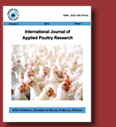|
|
|
|
|
|
|
|
Current Knowledge on Peste des petits ruminants: A comprehensive review
on clinical signs, diagnostic test and vaccination
|
|
Bwihangane, A.B.1,2*,
Gitao, C. G.2, Bebora, L.C2 and S. Nicholas |
|
1Department of Animal Science, Faculty of
Agriculture and Environmental Sciences, Université Evangélique en
Afrique,
PO Box 3323 Bukavu,
Democratic Republic of the Congo;
2Department of Pathology, Microbiology and
Parasitology, Faculty of Veterinary Medicine, University of Nairobi, PO
Box 29053-00625, Uthiru, Kenya;
3Animal
and Human Health program- International Livestock Research
Institute (ILRI) Hub, PO Box 30709-00100,
Nairobi, Kenya
|
|
| Abstract |
|
Peste des petits ruminants (PPR)
is currently considered as one of the main
transboundary animal diseases that constitutes a threat to small
ruminant production in many developing countries. It is a viral disease
of sheep, goats and wild ruminants (Impala,
Gazelles, Springbuck), with goats being more severely affected.
The disease is caused by a Morbillivirus, peste des petits ruminants
virus (PPRV) that belongs to the family Paramyxoviridae. The
disease cause high morality and morbidities to the tune of 90 to100% in
endemic areas with high economic impact. It was estimated in the FAO-OIE
Global eradication strategy report that the direct annual losses due to
PPR are between USD 1.2 and 1.7 billion.
This review is an attempt to
summarize the recent advancement in PPRV specific
clinical signs, diagnostic tests, vaccination and disease control
strategies. Clinically, the disease is characterized by sudden dullness
and fever, depression, anorexia, cutaneous nodules, severe purulent
ocular and nasal discharges resulting in reddening of conjunctiva and
matting of the eyelids, respiratory distress and coughing. The pathology
caused by PPR is dominated by necrotizing and ulcerative lesions in the
mouth and the gastro-intestinal tract. The recent molecular
characterization of PPRV virus isolates subdivides them into four
genetically distinct lineages (I, II, III and IV). Both viral isolation,
molecular and serological tests are reliable tests to confirm presence
of the disease. The virus is transmitted through a close contact with an
infected animal, although oral transmission is possible through
ingestion of contaminated feed and water. Separation of infected animals
from healthy animal at the first stage can minimize the chance of
transmission of the virus from infected to healthy animals. Advanced
molecular techniques are more accurate to detect the timely diagnosis of
the disease. Moreover, the vaccination campaign will improve the
prevention of the disease.
|
|
Keywords:
Peste des petits ruminants,
symptoms, diagnostics tools, vaccines, control |
| |
| To cite this article:
Bwihangane AB,
Gitao CG, Bebora LC and Nicholas S, 2016.
Current Knowledge on Peste des petits ruminants: A comprehensive review on
clinical signs, diagnostic test and vaccination.
Res.
Opin. Anim. Vet. Sci.,
7(3): 58-66. |
|
|

